Steps 1 – 5 are all about establishing boundaries when using math manipulatives so the classroom does not end up in a chaotic mess everyday! Steps 6-10 are about using them as learning tools.
Step 1. Although it’s tempting to have all your math manipulatives set up and ready to go in September, it’s easier to train your students to clean up and learn routines when you put out a few tubs at a time. As children learn to care for each set of materials. then introduce more.
Step 2. When teaching with hands-on materials, teach the children the correct names for them and the classroom category they belong with. For example, “These are pattern blocks and they are part of the math materials. All the math materials are in blue tubs.”
Step 3. Teach the boundaries for each new set of materials you present. “These blocks are not for throwing or smashing against each other. They stay on the math carpet.”
Remember, you don’t teach all of this in one day! The first month of school is training time.
Step 4. Teach the children how to clean up. You have to spell out the process for most kids and repeat it often! See a sample dialogue below…
“The pattern blocks are part of our math materials so we keep them in one of the blue tubs. Look at the pictures on the front of the blue tubs. This picture shows the pattern blocks. The words underneath the picture say pattern blocks. This is where you put the pattern blocks after you are finished working with them…”
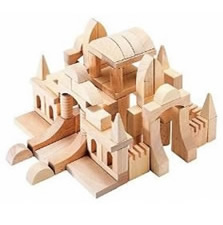
Step 5. When it’s time to clean up, don’t assume that your students are aware of safety issues. Children will throw objects across the carpet into a tub and accidentally hit another child. Many young children have only played with a few other children at a time and have to learn the dynamics of working with a larger group of people.
Step 6. Young children need to play with each math manipulatives for at least two weeks before you attempt to use the manipulative for a structured activity. This gives children a chance to explore the objects, find out what each item can and can’t do, and gives them time to learn new vocabulary.
At this stage of teaching with manipulatives, add to their vocabulary as they play. For example, “I see you are balancing the thicker, hexagon block on its side, but the thinner hexagon block falls over. It’s interesting that you can roll the cylinders and spheres easily, but not the cubes.”
Step 7. Finally, you get to teach with the math manipulatives! Make sure each child has enough space to work. Individual plain plastic table mats or pieces of plain white card spread out on the carpet work well to define boundaries. Don’t use patterned mats for work spaces.
First, teach the children a new skills using only the math manipulatives (no pictures or symbols). This is the concrete stage.
In the next 2 images, the children are learning what the number 4 means. The children build sets of 4 objects many times with various blocks and objects. Give them plenty of time and many opportunities to discover, “what does 4 look like with orange blocks? with the yellow blocks?
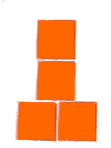
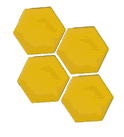
IMPORTANT! Do not move on to the representational or connecting stage with a child until he/she appears to successfully understand the idea using math manipulatives only.
Step 8. Representational or Connecting Stage
When a student is able to show you what 4 means with blocks (or another manipulative) introduce the same activity, only this time when you’ve created 4 with the math manipulatives, draw a pictorial representation (a picture) of the four objects.
As the kids see you working through the process, communicate your thinking and invite the children to participate.

In these images, the children have built sets of 4 with blocks and then traced around the blocks to make pictures that represent their sets. If any children seem ready they can add the symbol, 4, to their pictures.
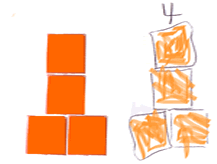
Step 9. Symbolic stage
Only after a thorough understanding of the connection between math manipulatives and pictures and symbols are children ready to work with symbols alone. Don’t rush things.
The symbolic stage may or may not be part of your kindergarten government requirements, depending on where you live.
Some children can successfully print the number ‘4’ without having any idea what that symbol means.
Only after going through the concrete and connecting stages, are children able to visualize ‘4’ in their imaginations. This means they have number sense for 4.
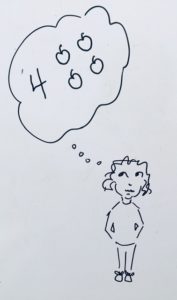
And finally, Step 10!!
Surprise… just because a child seems to understand, what the symbol “4” represents at a connecting or symbolic level, don’t assume that they will understand “5”. Start all over at the concrete stage, teaching with math manipulatives only. Use the same procedure with any math concept or operation (+-/x) you would like the child to learn.
Benefits of cleanup
Teaching children to clean up adds to the their understanding of classifying, ordering and sorting objects and is an opportunity to build their math vocabulary. E.g. “All one inch cubes go in this blue tub.” or “Please put the rectangular wooden blocks in this tub with the other geometric solids.”
Bonus!
Large printed labels on the tubs are great for teaching letter recognition, beginning and ending sounds, rhyming words and other language arts skills. Each tub has a picture and words to help the children put things away correctly. Use a large easy to read primary font rather than a label maker, which prints too small. During group times, refer to the letters if the tubs.
Check out my favorite math teaching supplies. I chose them because they are durable and are terrific for teaching multiple math concepts.
A note about printing symbols
Children need time to practice printing the digits 0 – 10, in order to be capable of using them when they are ready for connecting level work.
Start early in the year so children will not be struggling to print the numbers when they are ready to record their learning. Keep learning to print numbers tactile. Children like to paint numbers with their fingers or brushes, to form numbers out of play dough, or to make numbers with a variety of art materials. When they have mastered the formation of numbers, then they can practice printing numbers and symbols smaller with felt markers or pencils.